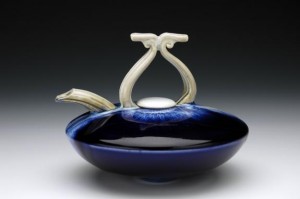An exciting new 3D printed self-glazing ceramic material is currently being researched, which is based on Faience, a technique that originated 7000 years ago to create Egyptian Paste. Faience was first used during the 5th Millennium BC and was the first glazed ceramic material invented by man. This Egyptian technique is based on quartz and alkali fluxes that have self-glazing properties, a process that can help ceramic artists and designers to glaze and vitrify 3D objects built on 3d printers with one firing in the 21st century.
Researchers at UWE Bristol, have received funding from the Art and Humanities Council to undertake studies into self-glazing 3D printed ceramics, inspired by the ancient Faience techniques. The researchers, led by Professor Stephen Hoskins at the UWE Centre for Fine Print, believe it is possible create contemporary 3D printable, once fired, self-glazing, non-plastic ceramic materials that contain the characteristics and quality of the Egyptian Faience.
The three-year research project will focus on three methods of glazing used by the ancient Egyptians. The first, “application glazing”, resembles our current modern glazing methods and the second, “efflorescent glazing”, uses water soluble salts. The third technique, “cementation glazing”, is carried out by burying the object in glazing powder in a protective glazing and then fired. These techniques will be used as the basis for creating modern printable alternatives.
As Professor Stephen Hoskins explains: “It is fascinating to think that some of these ancient processes, in fact the very first glazed ceramics every created by humans, could have relevance to the advanced 3D printing technology of today. We hope to create a self-glazing 3D printed ceramic, which only requires one firing from conception to completion rather than the usual two. This would be a radical step-forward in the development of 3D printing technologies. As part of the project we will undertake case studies of craft, design and fine art practitioners to contribute to the project, so that our work reflects the knowledge and understanding of artists and reflects the way in which artists work.”
Once developed, the resulting new form of Faience paste can be printed on a low cost 3D printer offering a new efficient way to create ceramics.




